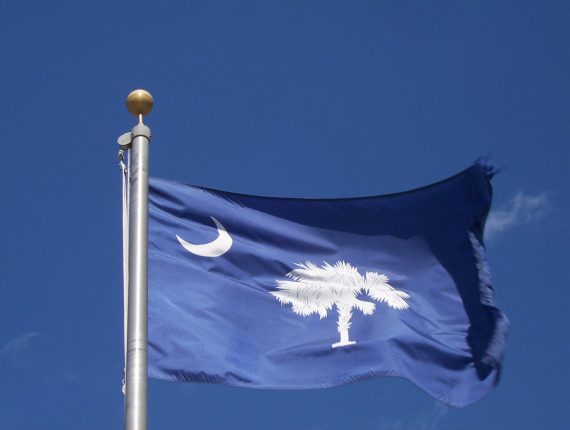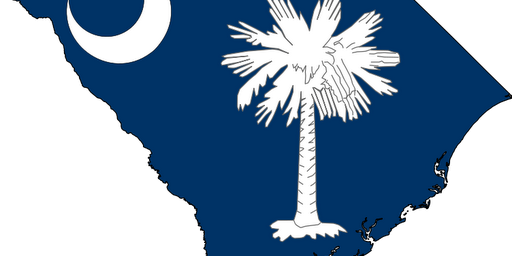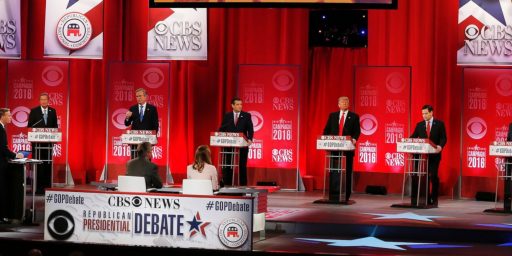Trump Barely Leading In South Carolina?
A new poll shows Donald Trump barely winning in a state that should be solidly red.
A new poll from Public Policy Polling has Donald Trump holding on to a surprisingly narrow lead in South Carolina, a state that has been solidly Republican in nearly every Presidential election for the past half century:
PPP’s newest South Carolina poll* finds that the state is trending toward being competitive in the Presidential race this year, just like in neighboring Georgia. Donald Trump has only a 2 point lead with 41% to 39% for Hillary Clinton, 5% for Gary Johnson, and 2% for Jill Stein.
The closeness is a function of Democrats being a lot happier with their party’s candidate than Republicans are with theirs. Clinton is winning 84% of the Democratic vote, compared to Trump’s 77% of the Republican vote. Although neither candidate is well liked by voters in the state Trump’s favorability, at 38% positive and 56% negative, comes in slightly worse than Clinton’s at 38/55.
Whether Democrats end up winning South Carolina in the Presidential race this fall or not, the generational differences in the state portend well for the party in the decades ahead. Trump is only ahead because of a massive advantage among seniors in the state at 58/30. When you look at everyone in the electorate below the age of 65, Clinton leads Trump 41/36. That suggests the potential for the Palmetto State to become much more of a battleground in the years ahead, just as in migration and the increasing diversity of the electorate has done in Southern states like Virginia and North Carolina.
If this number is anywhere close to being accurate, it’s a complete surprise and potentially a sign of serious trouble for the Trump campaign. For years now, the Palmetto State has been reliably Republican in Presidential elections, even in 1964 when Barry Goldwater was otherwise getting crushed by Lyndon Baines Johnson in one of the historic landslide wins of the 20th Century. That was the first election in which the state had gone for a Republican in a Presidential election since the election of 1876, the last post-Civil War election of the Reconstruction Era. After 1964, South Carolina has only gone for a Democratic candidate once, in 1976 when Jimmy Carter from neighboring Georgia was on the ballot and managed to bring the state back into the Democratic orbit for one election. Fellow southerner Bill Clinton was unable to do this in either 1992 or 1996. Additionally, the Palmetto State is typically one where the GOP’s margin of victory exceeds five percentage points and has often extended into the double digits. In other words, South Carolina has generally been one of those states that you automatically color in red or blue on an Electoral College projection map because there is rarely a question about which way the wind is going to blow there on Election Day.
Given all of that, a poll that purports to show Trump with a lead inside the margin of error is one that gives pause. If it’s accurate, then it suggests that Trump’s campaign is in bigger trouble than we’ve been assuming so far. It’s one thing to see him having trouble gaining a foothold in states that Democrats have typically won such as Pennsylvania, Michigan, and Wisconsin, or in battleground states like Virginia, Ohio, or Florida. It’s quite another to see him apparently struggling in states that Republicans ought to win easily, such as Utah, Georgia, and South Carolina. If he’s having trouble holding on to those states, even with more than eighty days left before Election Day, then it suggests the possibility of an Electoral College disaster akin to Michael Dukakis’s defeat in 1988, or maybe even something worse.
Before Republicans start panicking, and Democrats start celeb rating, the idea of states like South Carolina being in play, though, it’s worth noting a few caveats. First of all,as I noted there has been almost no polling in the state of the General Election so it’s impossible to tell if this poll is an accurate reflection of the state of the race or an outlier. The last poll of a head-to-head race out of South Carolina appears to be a November 2015 poll that showed Trump up by five points but that doesn’t really tell us much of anything. So, this poll could be a sign of some really bad news for the Trump campaign and the Republican Party, or it could be an anomaly. I suspect other polling companies will be running numbers in the state soon in order to try to find out what the answer to that question happens to b







Clinton is going to run the Eastern Seaboard table. Ha!!!
In every Presidential race going back to Truman whoever was leading two weeks after the conventions won the race. It’s two weeks after the conventions.
70 Republicans have signed a petition to Priebus requesting that he cut funding for Trump;
They want the money spent on Congressional races instead.
Anyone with the time to do so should look at the internals and complete question list of this poll. Huge majorities said they favor ‘background checks’ and ‘terror-watch-list’ qualifications on all firearm purchases for just one example of it’s surprises. I had to double check that this was really really SCarolina!
The ground is shifting right out from under the so-called-conservatives.
I’m surprised he’s doing that well. South Carolina is obviously a radical Muslim state, based upon the flag. 🙂
It’s an interesting challenge to the “solid South,” especially since Clinton, unlike her husband, is not perceived as a southerner.
@John E. Bredehoft: Also, the South has become much redder since the 1990s. I suspect even Bill Clinton would have a hard time winning Arkansas today.
According to the RCP polling averages today, Trump is losing every single battleground state, including Iowa. In some cases,, Clinton has an almost ten-point lead over him.
Georgia has shifted to Clinton. Why should South Carolina be different?
Imagine if Clinton does run the Eastern Seaboard on November 8. The election will be called at 8 o’clock EST. We may see Karl Rove disanimate right before our eyes.
@C. Clavin: What’s that saying about rats and ships? It escapes me just now.
I howled.
I guess Trump was right when he said the polls were tightening rapidly.
Just not the way he meant.
That brings up a point I’ve been thinking about lately. The terms “red state” and “blue state” were coined in the 1990s and only started to become widely used in the 2000 election. What is rarely mentioned, however, is that in many ways the concept behind these terms wouldn’t have made a lot of sense before the 1990s. Imagine taking a time machine back to 1984 and trying to explain to someone what red states and blue states are. Reagan won 49 states, and so by definition almost the entire country consisted of “red states.” And even by 1988, when Bush’s popular-vote share was about the same as Obama’s in 2008, he still managed to win 40 of the 50 states.
I think 1992 was the first “modern” election in the sense that each of the major-party nominees came into the race with a floor of roughly 20 states safely in his column. That’s been the situation ever since (even if the exact states labeled as red or blue have shifted a little), and we’ve gotten so used to it we sometimes forget that it wasn’t always that way, and it won’t necessarily stay that way forever.
@grumpy realist: That is brilliant, Grump. Do you have a cite? I need to share that.
@Gromitt Gunn:
“GOP consultant and Never Trump member Rory Cooper.”
Quoted in Hufpo
http://www.huffingtonpost.com/entry/donald-trump-connecticut_us_57acaf59e4b0db3be07d74da
perhaps from the Cincinatti Enquirer
http://www.cincinnati.com/story/news/politics/elections/2016/08/10/email-trump-campaign-scrambling-sw-ohio/88514306/
@John E. Bredehoft South Carolina is obviously a radical Muslim state, based upon the flag. 🙂:
@Gromitt Gunn: Vot eta.
@grumpy realist: Gracias.
@Kylopod: Dukakis had a strategy of trying to win the Northeast, the industrial states in the Mideast and the Pacific States(Basically, what we call Blue States today), while the so called “Finkelstein Box” encompasses what we today see as Red States.
The Modern GOP is a Southern State, and that makes the definition of Red States a little obvious. 😉
@Scott:
Since at least 1860. Actually make it the 1820s, with John C. Calhoun.
@Andre Kenji: But that just points to the double meaning of these terms. On one level, “red state” and “blue state” are simply a method of visualizing an electoral map. That was their original sense when they were coined back in the ’90. But they’ve come to signify something more deep-seated and cultural. When someone says “I live in a red state” or “I live in a blue state,” it’s supposed to suggest something about the people who typically reside there, their values and lifestyle. That was the sense in which Barack Obama used the term in his 2004 convention speech, and it’s also the sense behind the name of the website RedState.com. But if it’s the 1980s when states like Maryland and New Jersey were voting Republican, the concept becomes much more ephemeral.
@Kylopod: In the 80´s. there was more vote-splitting, that made a lot of difference. But since 1972 that the GOP is a Southern Party at Presidential Level, and that in some sense is the definition of Red State.
@Andre Kenji: I’d agree that people tend to think of Southern states (and some Western rural states) when the phrase “red state” is mentioned. “Blue state,” on the other hand, conjures up pretty much the entire Northeast, plus California. But my point is that this is more a matter of mental association than the technical definition of the terms as markers of how particular states vote in presidential elections. Remember, Carter won almost the entire South in 1976, and Clinton won several states in that region that have since gone solid red, including Louisiana, Georgia, Arkansas, Tennessee, and Kentucky.
I guess what I’m trying to say is that when most people use the terms “red state” and “blue state,” they’re usually implying something about the state’s very essence, whereas technically these phrases mean simply whether they voted Republican or Democrat in the most recent presidential election, which is something that can change from one election cycle to the next. The conflation of these two meanings has happened in part because since 1992 they’ve more or less coincided: the states we think of as fundamentally red or fundamentally blue have pretty consistently voted that way in all the presidential elections between then and now. It would seem odd to argue that Alabama was fundamentally a red state in 1976 even though it was supporting the Democratic nominee, or argue the same thing in reverse about New Jersey in 1988. My point is that we haven’t had to confront that paradox ever since the terms “red state” and “blue state” were coined in the early ’90s. If Hillary somehow wins South Carolina or Utah this year, we might.
@Andre Kenji:
I’m not sure that’s quite accurate. Nixon won 49 states in 1972, as did Reagan in 1984. The GOP victories in 1980 and 1988 were also 40+ state landslides. State legislatures and Congressional seats only truly began to shift to Republicanism in the 1990s.
By all means, the shift was happening-the biggest margins of victory occurred in the South-but that didn’t make the GOP a “Southern” party, per se. The GOP was a throughly functional national party from 1972-1992, and there were plenty of Reagan Democrats in the North who would end up voting for Clinton in the 1990s, unlike their Southern counterparts. Southernization took time, and it also took a changing South, particularly on economic issues.
@Kylopod:
Well, you could be a “red state” and vote Democrat in 1976, or vise versa. It was less clear cut. Vietnam and the surrounding patriotism issues were no longer around to help the Republicans, as was the case in 1972. Carter was an evangelical who wanted to move away from cold Nixon/Kissinger style Realpolitik in foreign affairs and lessen government intervention in the economy: he was hardly LBJ 2.0. Ford, meanwhile, was busy defending Nixon-era initiatives like detente with the USSR and the ERA, which definitively hurt him. On race, the CR Act was clearly a fait accompli to most voters by 1976, but there were new issues-busing, for example-that took its place, and the ascendence of minority populations in border states like NC, VA, FL that eventually gave Obama his victories there wouldn’t get started for a couple of decades more.
I think 1992 was the breaker point in when the lines began to really harden, particularly with the post Cold War power shifts in the GOP.
The interesting thing about SC is that they have the two remaining ‘non-white’ (and non-His[anic)Republican higher office holders in Tim Scott and Nikki Haley. (With Jindal thankfully gone, I don’t think there are any other ‘non-white’ Governors, except for Susanna Martinez.) Maybe, while staying Conservative and ‘Southern’ some SCers are really trying to overcome their extreme racist pasts.